Inside the Camps of Migrants Halted in Mexico
Photojournal by Lexie Harrison-Cripps
Published on
The Department of Homeland Security has just begun a program of restoring “safe and orderly processing of the southwest border.” Under the Trump administration, tens of thousands of asylum seekers were forced to wait in Mexico for the duration of their immigration proceedings under a policy called Migrant Protection Protocol (MPP).
As a result of the policy, thousands of men, women and children found themselves waiting in Mexican border towns. Around 3,000 lived in tents on the banks of the Rio Grande in the city of Matamoros, Tamaulipas, which borders Brownsville in Texas. The U.S. Department of State considers Matamoros so dangerous that consular staff may only travel within a limited radius from the consulate and at certain times of day.
In March 2020, as borders closed due to the pandemic, court dates were suspended, further delaying immigration proceedings. Many people gave up on the idea of entering the United States legally and numbers in the camp dropped to around 700. Some people crossed illegally, some headed back to their home countries and others moved into crowded, often squalid, apartments in the city.
As the year progressed, a tall wire fence, topped by loops of razor wire, enclosed the camp. The only entrance was strictly policed by Mexico’s National Institute of Migration. Journalists were largely excluded from documenting the conditions of the camp.
Many, including young children with no access to formal education, have survived in the camp for more than 18 months. Now, there is the proverbial light at the end of the tunnel.
Eight nations are represented within MPP: Mexico, Guatemala, Honduras, El Salvador, Nicaragua, Cuba, Haiti and Venezuela. Mexicans are exempt from the program; however, the closure of the border meant that they too were forced to wait.
Over 70,000 people have been affected by MPP in 2019 and 2020, according to the nonpartisan TRAC Center.

A child’s birthday party is set up next to the razor-wired border of the tented encampment. The red structure in the background is the bridge that leads to the United States of America.
As many people have spent over a year in the camp, life must go on. Events such as birthday parties take on great significance and become a central focus in the days beforehand. Loud music plays as children swing at piñatas, surrounded by balloons and cake. Sometimes the National Institute of Migration shuts down the parties, but often the music goes on late into the night.

The evening sun falls on washing lines in the tent camp, seen through the fence that was erected in the summer of 2020.
Around 700 people are still living under tarpaulin or in tents inside the fenced-off area. The entrance is tightly controlled by Mexico’s National Institute of Migration, with wristbands signifying which part of the camp a person lives in. They also enforce strict rules banning drugs and alcohol from the camp.
Every day aid workers arrive to provide medical care, water, clothing and engineering support to prevent flooding.
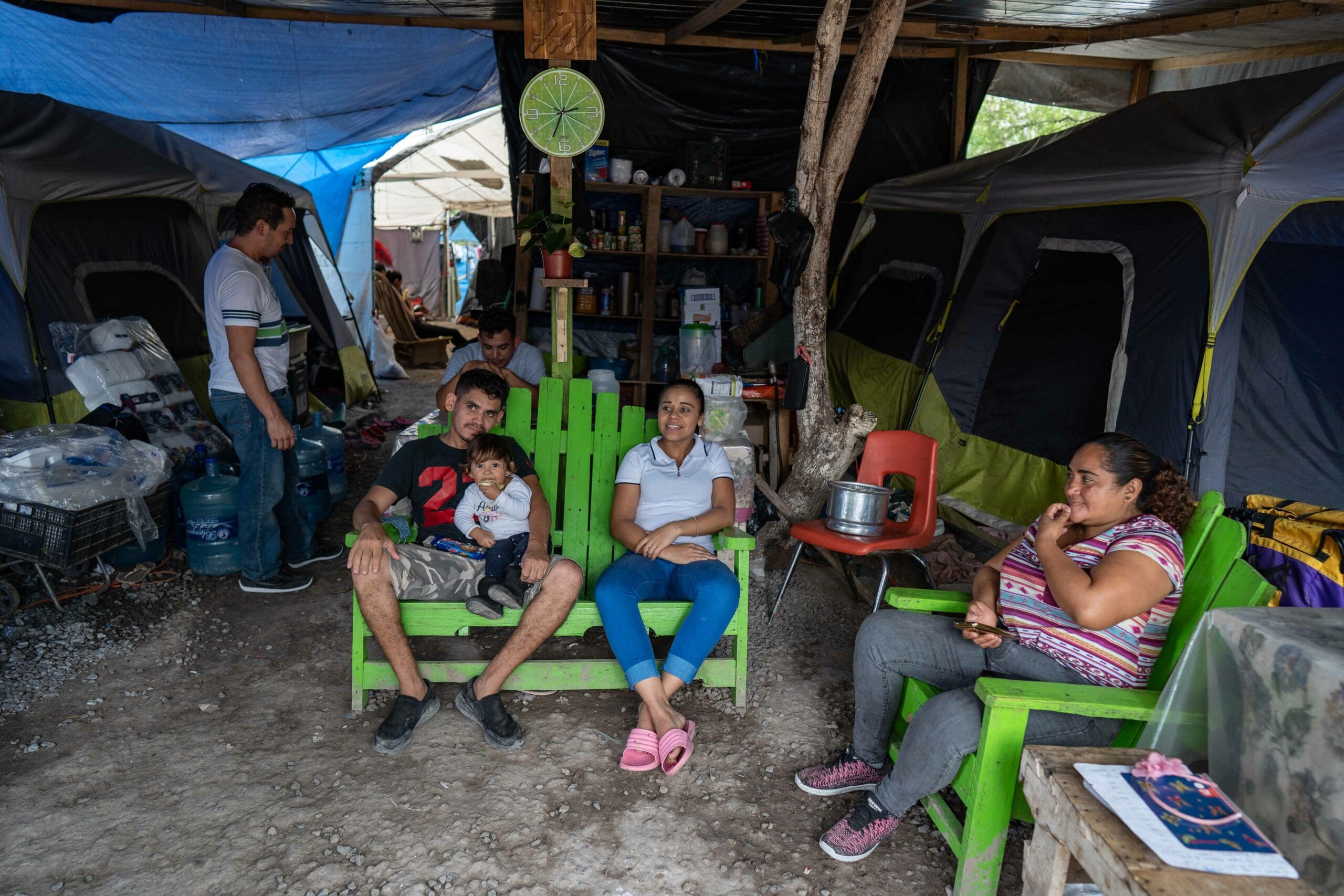
Workers in a restaurant in the camp take a break after the lunchtime rush.
Little businesses have sprung up inside the camp offering food, sweets, haircuts or electrical charging stations. With the pandemic came restrictions on dining in; this little restaurant was no exception. The tables and chairs were removed for customers and the food became takeaway only. Around the edge of the communal area are the tents where the residents sleep.
The restaurant is famous here for its pupusas, cooked by the woman on the far right.

A young girl from Nicaragua rides her bike on a basketball court in the middle of the tented encampment.
She has spent 18 months in this camp, with no access to formal education. To anyone walking here, the children appear happy and relaxed as they play in the woods. However, parents will explain that things are very different at night when their children cry and ask to go back to the home life that they once knew.
In the background, a mobile medical unit is permanently based in the center of the camp, with a team of doctors, nurses, pharmacists and emergency medical technicians. They offer COVID testing and various specialist clinics, such as gynecology.

Crates are stacked to form a shelving unit in a makeshift kitchen in the woods.
People in the camp are meticulously clean, taking great pride in their living areas. Kitchens are often shared between groups of people. As in any other household, some prefer to cook and some prefer to wash up.

A communal kitchen with fully stacked shelves lies next to an old basketball court in the middle of the camp.
Cooking is done with firewood, often using the inside drum of an old washing machine to contain the fire. Nobody in the camp escapes the smell of smoke. With the camp completely enclosed by high, razor-topped wire, fire is a big risk.
Aid workers installed several fire extinguishers throughout the camp and volunteer firefighters came to explain how to use them. Cooking under tarpaulin can also produce toxic fumes, although the residents have no other choice but to make do with what they have.

A toddler sleeps in a hammock as his mom and brother rest next to him.
Days pass slowly in the camp with very little to do for entertainment.
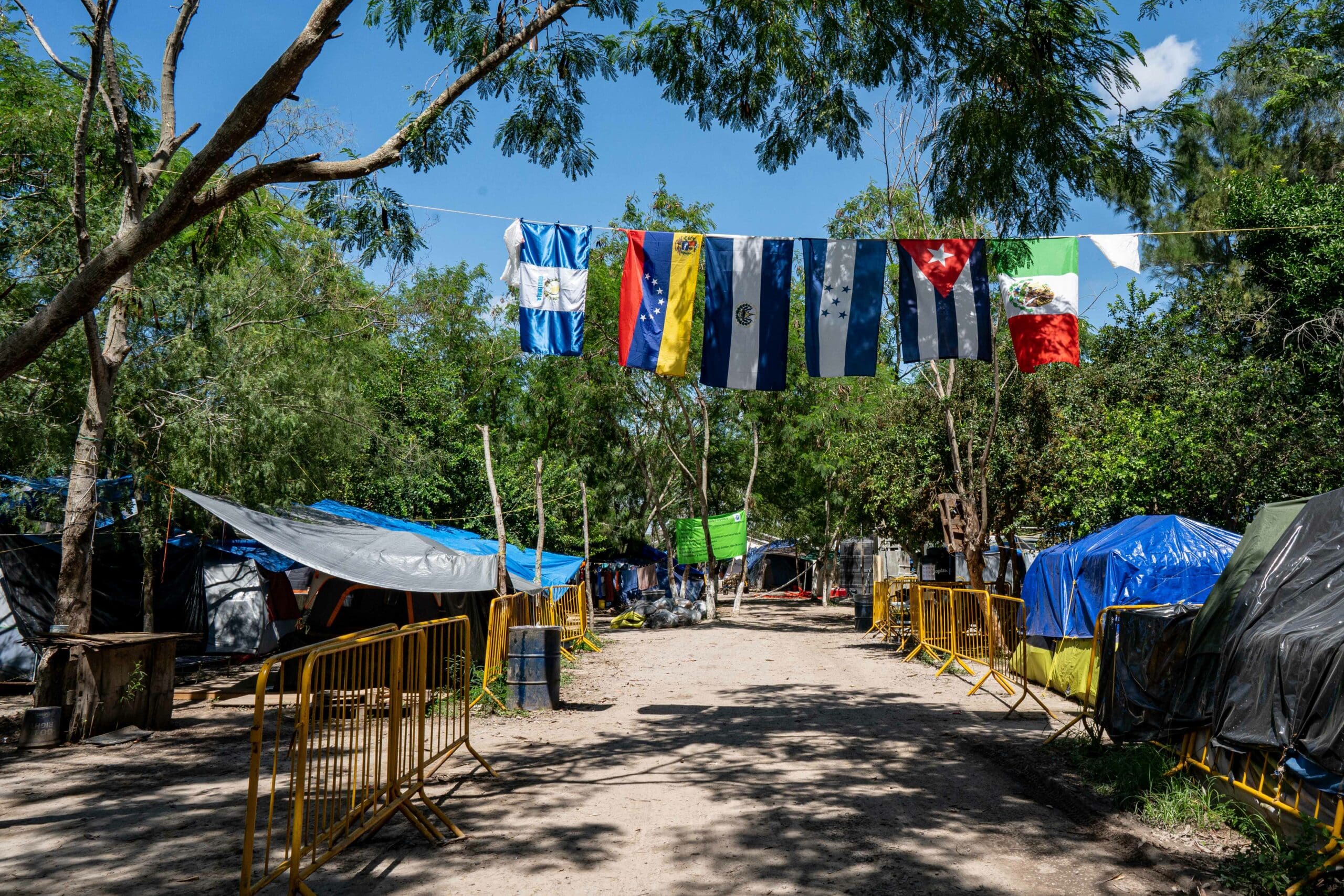
Flags representing the residents’ different nationalities hang over the main path leading into the camp. The barriers allow people to mark off a little bit of land that is akin to a front lawn.
There are at least eight countries represented in the camp, including Mexicans who have been waiting there since U.S. immigration courts were suspended in spring 2020.
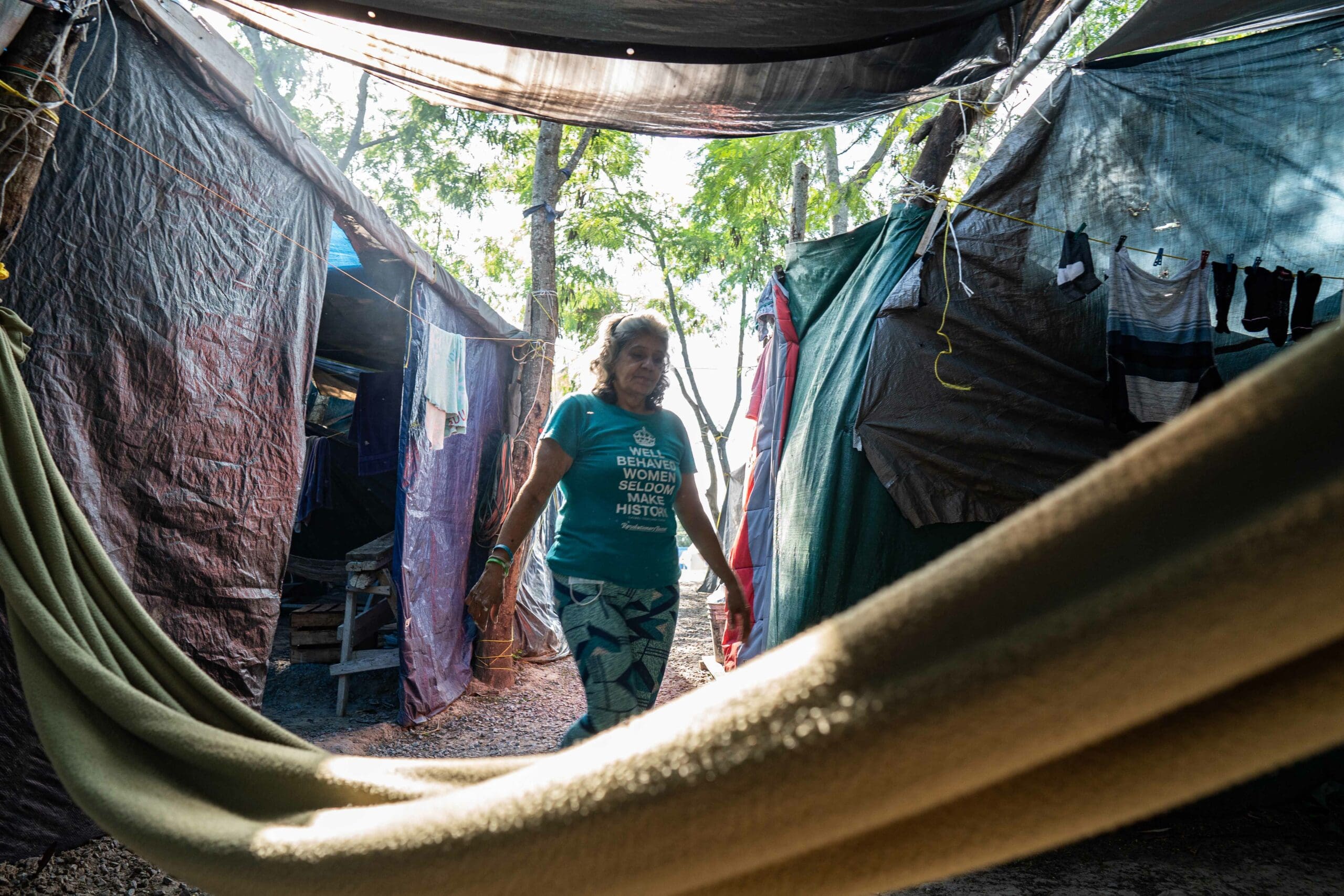
A Venezuelan woman walks through the camp to her communal kitchen. She wears a T-shirt that says “Well Behaved Women Seldom Make History.”
She has medical conditions that put her in the at-risk category for COVID-19 and yet she was forced to wait for over a year in the tent village for her asylum hearing in the United States.
Although this lady is making the journey to the U.S. on her own, her neighbors have become her closest friends and the sense of community is strong in the camp.

Makeshift washing lines hang next to a shower block and a broken water container.
Gullies have been carved through the camp to prevent flooding. Engineers spent months digging out the gullies after many of the tents were flooded.
While the shower block is relatively sophisticated for camping, many of the residents complain that using them leads to fungal infections. As a result, several people have rigged up their own bucket showers using tarpaulins for privacy.
There are many hand-washing sinks around the camp and a few larger sinks that serve as clothes-washing stations.
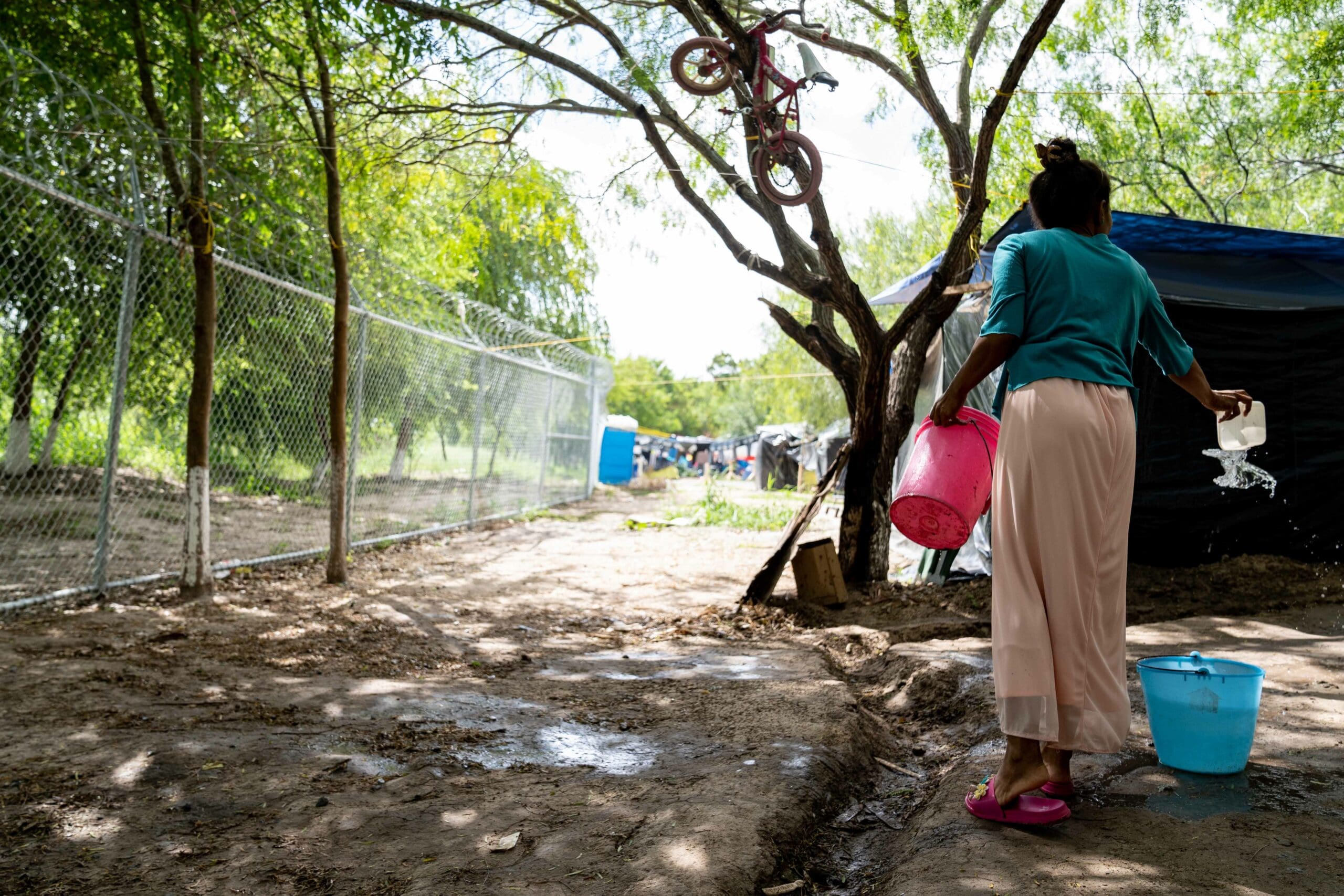
A woman throws water on the ground in an attempt to control the dust outside of her living area. Maintaining her space is very important to her.
Living in the woods makes it hard to stay clean, but this lady takes great pride in her appearance. She proudly showed off her costume jewelry collection, which is hidden in her tent. She also runs one of the restaurants in the camp, often cooking for dozens of people at once.
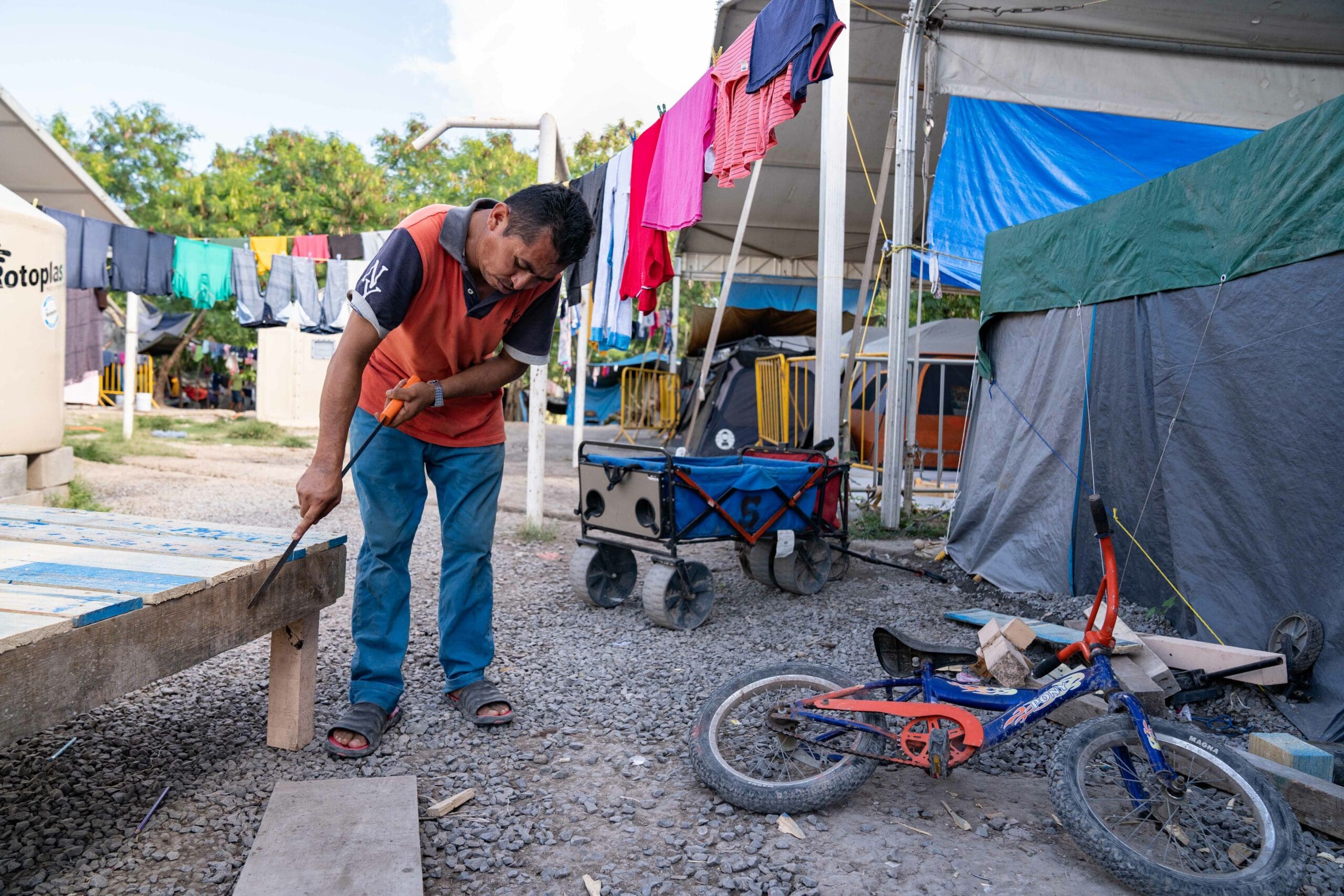
A man makes a bed frame from old wooden pallets. Without sandpaper, he uses the edge of his machete to smooth away any splinters from the edge of the frame. Although local aid workers have distributed some tools, migrants must often improvise.
As this man made his bed, several other residents came to watch and chat. The conversation moved on to the materials that he had managed to acquire before another resident asked me if he could show off the bed that he had made. Finding screws, as opposed to nails, means one can make a bed that is considered to be of a much higher standard.
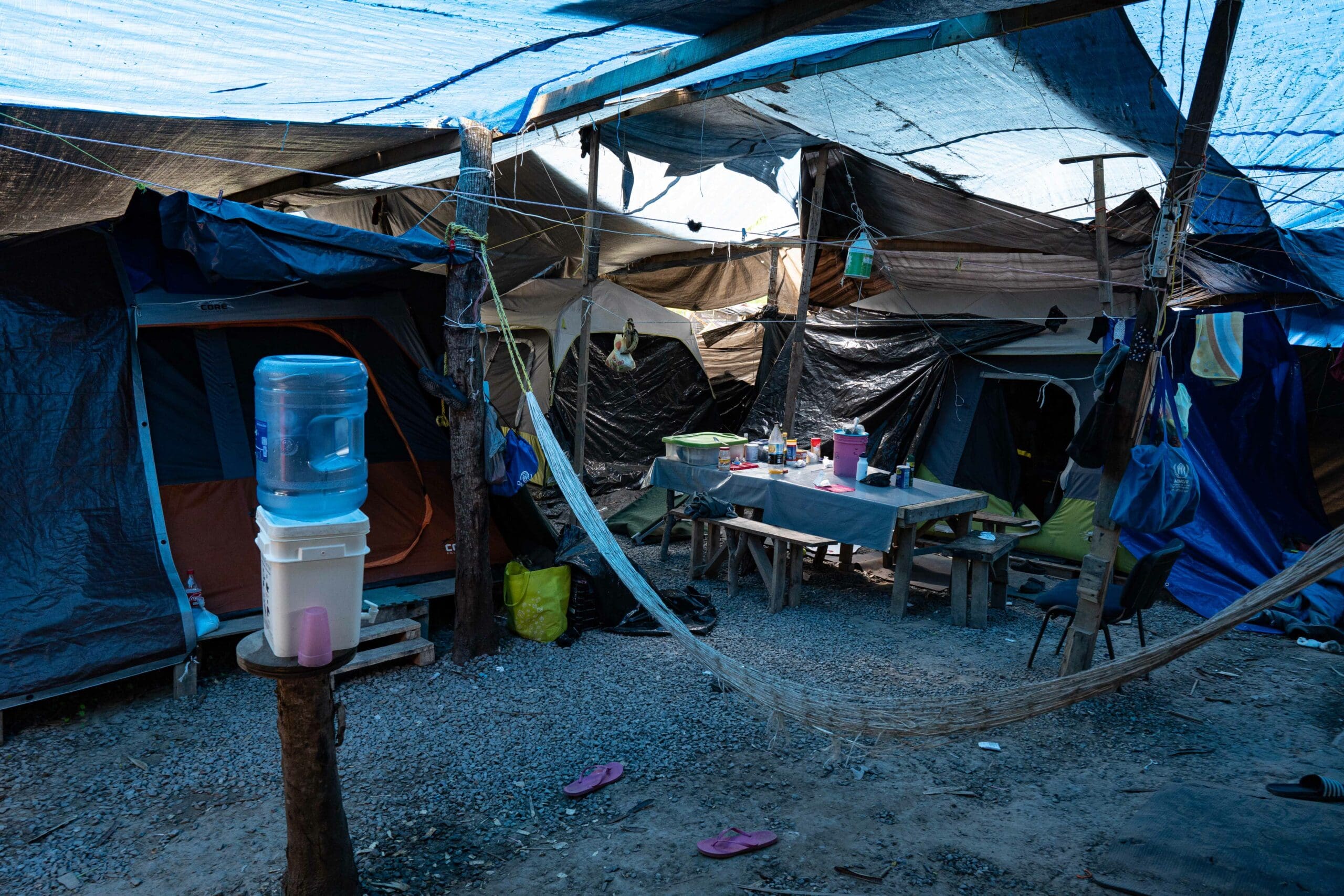
A communal area is seen with various layers of tarpaulin forming a makeshift roof in an attempt to keep it dry in the heavy rains. The camp itself is a maze of little corridors between the tarpaulin, small communal areas like this one or little kitchens.
One night in the camp, several men came in with large batons as weapons. They were obviously hunting for someone. The people in this communal area took me in while it was happening.

A young woman sits on the edge of her bed in a row of tents under a large white dome.
She asked not to have her face shown in the image, as she was afraid of possible repercussions. She no longer has an active asylum claim after she was kidnapped on her way to her hearing. Failure to attend a hearing means that the case is closed. As a result, she is unsure what will happen to her claim now.

Following heavy rainfall, the river burst its banks and flooded the camp.
While many residents moved their tents to higher ground, the waters affected numerous people. Poisonous snakes and rats frequently swam through the water. The bin liners stacked along the water’s edge were filled with ruined tents and belongings.
Most of the camp’s residents took part in the cleanup operation.
All Photographs by Lexie Harrison-Cripps
Co-published by La Opinión
Copyright Capital & Main 2021